Membership Pricing: The Essential Guide (Plus 10 Examples Of Membership Site Pricing Models)
Launching a membership website is an excellent way to build a community and make a profit – especially if you have a unique business idea. However, deciding on a membership pricing model can be challenging.
Fortunately, there are several options to choose from. For instance, you could charge a monthly subscription fee, or offer custom pricing. Once you’ve chosen your approach, you can set different prices to make your membership plans more accessible.
In this post, we’ll go over the basics of membership pricing. Then, we’ll share some of the most common membership site pricing models and offer some strategies for setting the right price. Let’s get started!
An Introduction to Membership Pricing (And Why It's So Important)
Launching a membership website can be an excellent monetization strategy for online entrepreneurs. With a membership site, you can transform a blog, online following, or your skills into a profitable business:
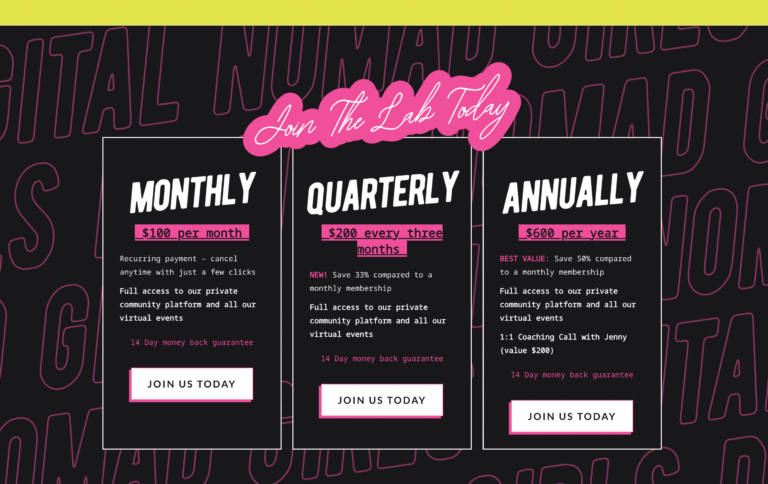
What's more, if you have enough material, a membership site can be a great way to generate a passive income. For example, you can create all of your content once and offer it to members at a monthly or annual fee.
When it comes to membership pricing, choosing the appropriate model and price is key. Once you find the sweet spot, it'll be easier to convert your visitors into paying members.
At the same time, you wouldn't want to make your membership plans so cheap that you're unable to turn a profit. Therefore, you'll need to consider factors like overhead costs, the competition, and the size of your membership base.
Essentially, correctly pricing your membership site can spell the difference between success and failure. So, you'll want to take this process seriously.
Furthermore, you'll want to make sure you have the right tools to set your membership pricing. If you have a WordPress site, you can use a plugin like MemberMouse:
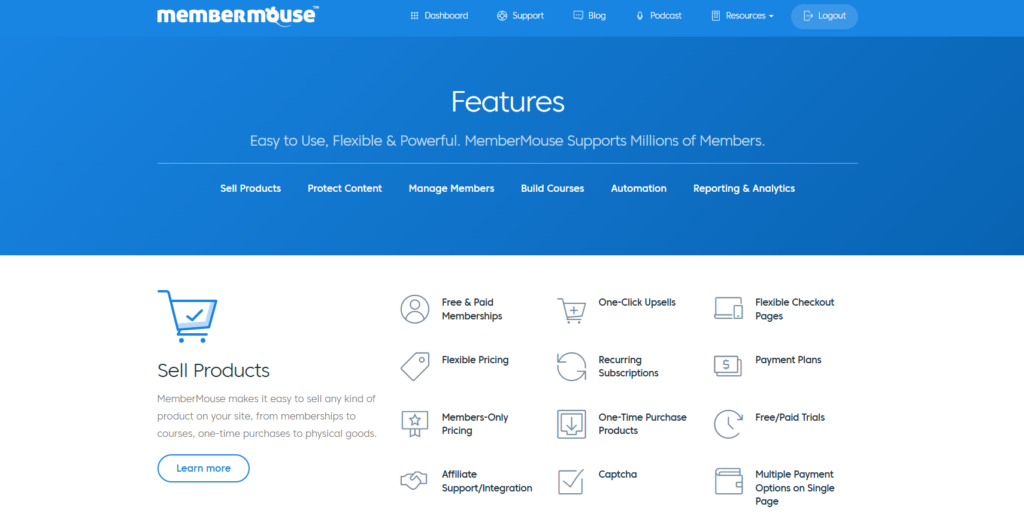
This tool enables you to create many different types of pricing plans. For instance, you can offer free and paid memberships, set up recurring subscriptions, and even establish flexible pricing.
Plus, MemberMouse makes member management a breeze, enabling you to easily upgrade or downgrade members, issue refunds, and much more. You can even set up one-time purchases alongside your memberships.
10 Common Membership Site Pricing Models
Before you set an actual price for your membership website, you'll want to explore the different pricing models and how they work. This way, you can choose a strategy that makes sense for your business.
Let's look at ten common pricing models for membership sites.
1. Fixed Lifetime Fee
One approach to membership pricing is a fixed lifetime fee. As the name suggests, members will make a one-time payment and then get access forever.
This strategy is not so common for content or community-based membership websites. In fact, it's often used for SaaS tools.
For example, Elegant Themes offers just two payment plans in its pricing model. Users can opt for yearly or lifetime access:
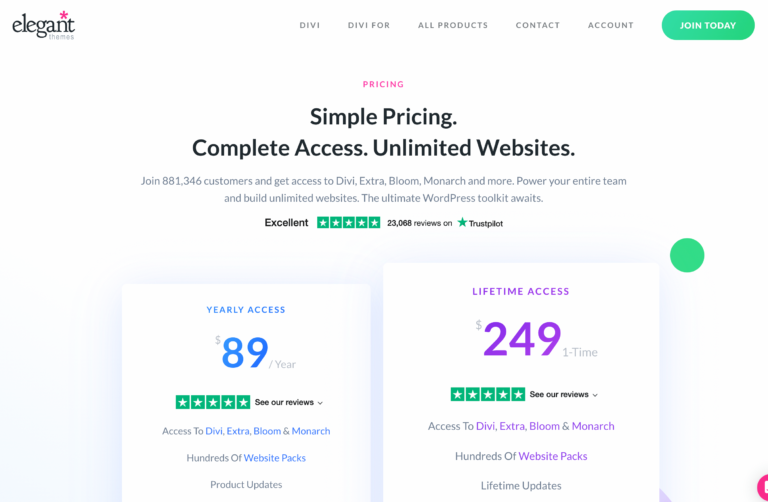
Typically, when members get lifetime access, they also get access to all future updates. However, they might only get customer support for a limited time.
This membership pricing model is best suited for software businesses because the Return On Investment (ROI) is likely higher for both members and companies.
2. Recurring Subscription Fee
Offering a recurring subscription fee is one of the most common membership pricing models. This is usually charged as a monthly or yearly subscription.
As an example, bestselling author and self-help expert Mark Manson offers a premium membership for access to his content. This subscription includes articles, video content, and more:
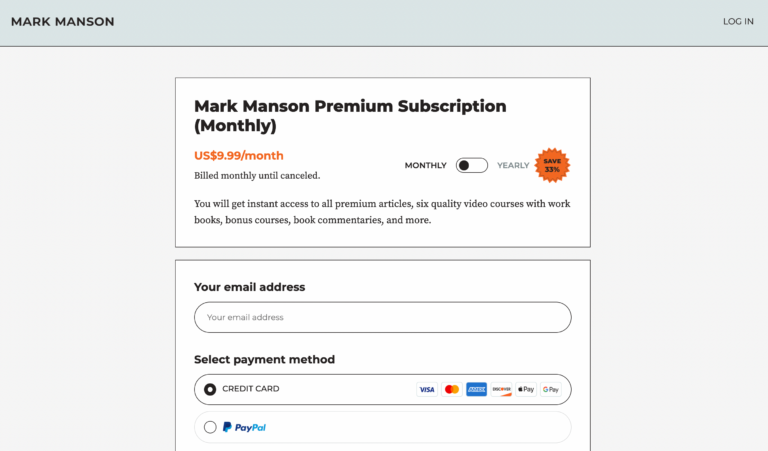
Manson also offers a 33% discount if you choose a yearly subscription over a monthly one. This is a common practice that benefits both parties.
Essentially, it gives members more value for less money and can help business owners forecast their profits more accurately.
3. Tiered Pricing
Next up, we have tiered pricing. This membership pricing model gives people more choices, offering multiple membership levels with different benefits.
The great thing about this type of membership pricing is that it gives members the potential to upgrade if/when they can.
4. Freemium Pricing
Freemium pricing is another popular strategy. As you might have guessed, it allows members to choose between free and premium plans.
As an example, the popular website Food Blogger Pro offers tons of free content:

However, followers can sign up for a premium plan to get access to a private forum, online courses, and more:
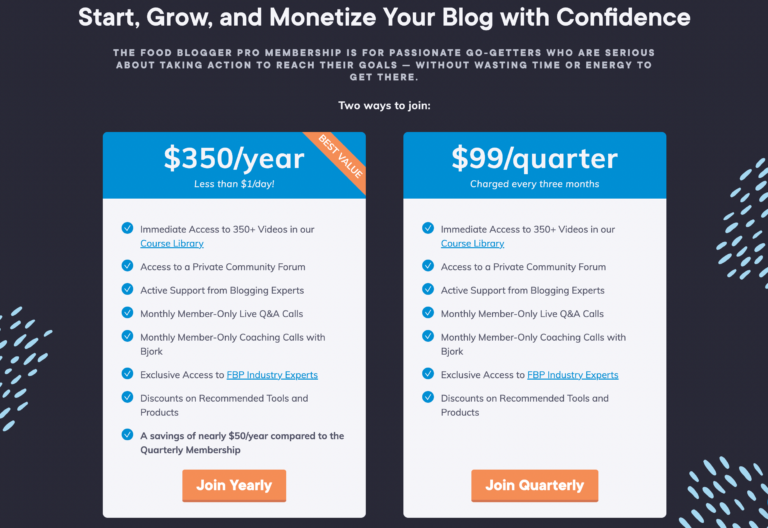
Similar to tiered pricing, freemium pricing enables users to get a taste of your content, and then upgrade if they want more features. This is an excellent sales strategy as it can be hard to convince members to pay if they don't have a real sense of what they're buying.
5. Custom Pricing
Custom rates are another strategy worth considering, particularly when catering to a wide range of customers with differing needs.
In fact, online business tools typically offer bespoke enterprise memberships:
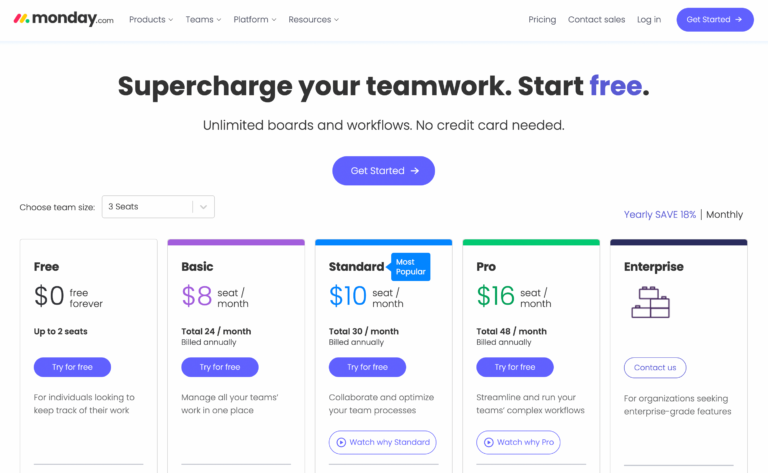
Companies that have the resources to offer custom pricing will want to prioritize their highest-paying members. For example, you'll need to create a membership that's tailored to their needs and budget.
This personalized approach can help you retain valuable clients.
6. Group Pricing
Sometimes memberships are designed specifically for teams. In this case, you might consider setting a group price.
Once again, this is a common practice among SaaS businesses and project management software like Zendesk. Often, group pricing plans let you select the number of users:
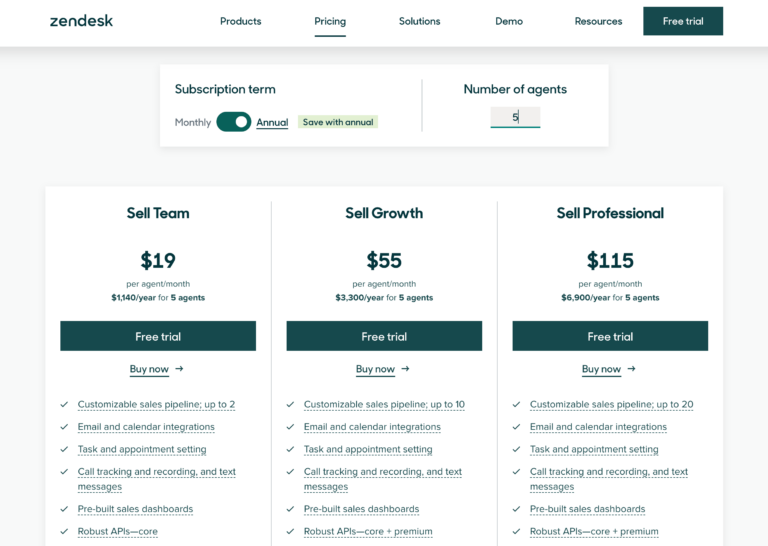
In the case of Zendesk, you're able to choose the number of agents you'd like to include on your subscription. Some companies may even charge per user (e.g., $20 dollars per user per month).
7. Usage-Based Pricing
Usage-based or “pay as you go” pricing allows members to pay depending on how much content they consume or the number of services they use.
For example, if you run an online magazine, you could charge members based on how many articles they read per month.
Similarly, if you run a dog-walking business, you could use a membership site and charge members for total walks at the end of the month.
8. Hybrid Pricing
Membership sites can also offer hybrid pricing. This means rolling two different pricing models into one.
For instance, you could offer a tiered pricing plan that gives members access to certain features and charge them a flat monthly fee.
Then, you could also allow them to purchase add-ons for a one-time fee. You might even put a limit on one aspect of their usage and charge them more if they go exceed it.
For example, HubSpot offers tiered subscription pricing, but members have to pay for additional marketing contacts:
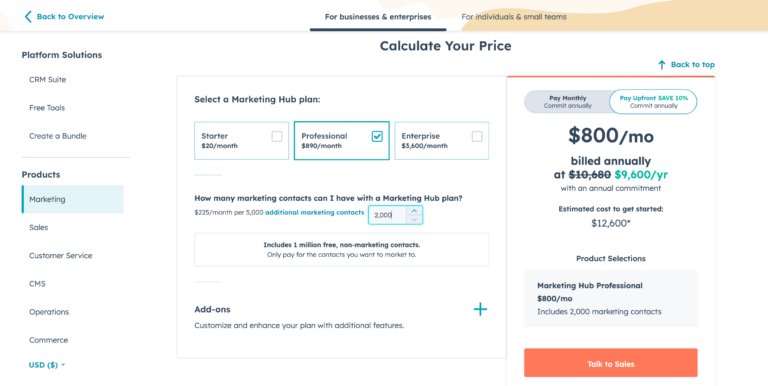
Likewise, you could provide membership extras at an additional charge. These may include things like templates or photo bundles, one-on-one coaching calls, and more.
9. Donation-Based Pricing
If you run a non-profit membership website, you might consider a donation-based or “pay what you can” approach.
One popular example of this is the Sierra Club:
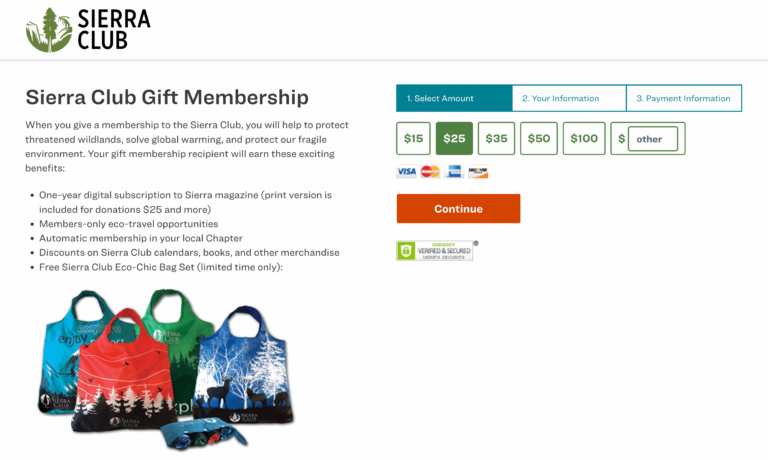
You could suggest some donation tiers or let people set their own membership price. Even if you don't run a non-profit, this can be a great way to make your memberships accessible to a wider audience.
10. Buy Now Pay Later
If you're worried that your members will have a hard time paying your membership fees outright, you can also offer “buy now, pay later” plans.
This type of installment-based payment is on the rise across different industries. Therefore, you might consider it a way to remain competitive in your niche.

How to Set Your Membership Price (8 Key Strategies)
Now that you're aware of the most common membership pricing models, you should find it easier to set your prices. However, here are some additional strategies to help you get started.
1. Define Your Unique Selling Point (USP)
Before you establish a price for your membership website, you'll want to define your unique selling point (USP). This way, you can more easily assess the value that you're offering to customers.
At the same time, this can lead to more conversions. That's because you can market your USP to help reassure potential members of the value they'll enjoy when they sign up as a member.
2. Establish Your Target Audience
Once you've established your USP, it should be easy to define your target audience. You may want to create a buyer persona in order to establish what type of customer you want to sell to.
This is crucial for a number of reasons. Firstly, it can help you cater your product, content, or services to the right people.
Additionally, it should give you a sense of their budget, and how much you can realistically charge.
Of course, you wouldn't want to push the limits here. People shouldn't have to think too hard about purchasing your membership, because it should be reasonable and affordable for them.
3. Research Your Competitors
In addition to defining your target audience and USP, it's also a good idea to research your competitors. You'll want to take some time to identify websites that offer similar memberships and see what they're charging.
Of course, your membership pricing should be completely unique to your needs. However, this information can be helpful when making that decision.
4. Consider Your Costs
When setting your membership prices, you'll also need to consider your costs. This can include any expenses that were required to launch your business as well as any recurring overhead costs you expect in the future.
When determining these costs, make sure to be meticulous and take note of everything. Costs can include everything from web hosting to paid advertising.
5. Factor in Promotions and Deals
When setting your membership pricing, you should also allow some wiggle room for promotions and deals. For example, you might want to offer free trials, discounts for annual members, etc.
This means that you'll likely need to price your plans a little higher in order to offer discounts as a profitable sales strategy.
6. Diversify Your Revenue Stream
It's also important to point out that membership sites don't need to rely solely on member fees. As we mentioned earlier, you can also offer one-time purchases.
As an example, you might offer a membership fee for your online courses. At the same time, you could charge an additional fee for your ebook or other optional course materials.
7. Calculate Your Ideal Membership Size
Business forecasting is crucial for all companies, including membership sites. For example, you'll want to set tangible goals and reasonable targets, like securing a particular number of members within a specific period.
This way, you can calculate how much you'll need to charge each member based on this estimation.
8. Modify Your Membership Pricing As Needed
It's important to remember that you can always modify your membership pricing as your business evolves.
Ideally, you should track key metrics such as the retention rate, the number of upsells, etc. This information can help you assess whether you need to return to the drawing board.
If you notice that your signups are low, or you're struggling with member retention, you may want to lower your membership fees, provide more value, or offer better promotions.
Conclusion
A membership site can be a great way to monetize your site or create an additional revenue stream, but you'll need to choose the right pricing model for this strategy to work. For example, you might offer a standard subscription fee or a fixed lifetime rate.
Defining your unique selling point and target audience can help you set the right prices for your memberships. It's also a good idea to research your competitors to get a feel for the market. Plus, you’ll want to consider factors like overhead costs.
Do you have any questions about how to price your membership site? Let us know in the comments section below!
If you liked this article, be sure to follow us on Facebook, Twitter, Pinterest, and LinkedIn! And don't forget to subscribe in the box below.










